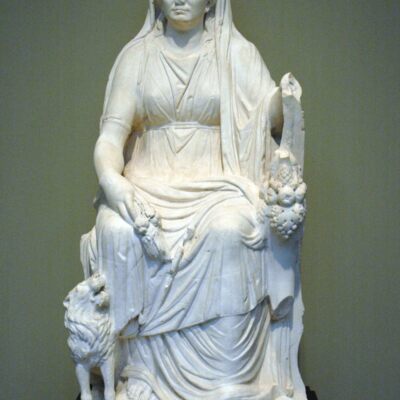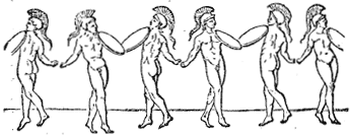Chapters
Cybele (or Cybebe) was a Phrygian goddess of fertility, harvest, spring and fortified cities, and guardian of the dead. She has been worshipped for millennia throughout Asia Minor as the Magna Mater. In Phrygian mythology, Cybele’s young lover was Attis, who was the god of vegetation and spring. He was depicted as a young shepherd. The cult of Cybele survived in Rome until the 5th century CE.
In the 3rd century BCE, the most important sanctuary of Cybele was in Phrygia, at Pessinunte (Pessinus, Pessynunte), on the river Sangarius (now Sakarya), at the foot of Mount Dindymus, which was her sacred mountain, which is why the Goddess was nicknamed Meter Dindymene. There was a statue in the sanctuary – a black stone – which was not a traditional statue of the Goddess, but rather an archaic symbol of her. It was said to have fallen from the sky, most likely it was a meteorite set in silver, in the shape of a female figure. At Troas, Cybele was worshipped under the name of the Idaean Mother, in Latin Mater Idaea. This name came from Mount Ida, located near Troy, which was also dedicated to her. She was also worshipped in other cities of the Troas, Lampsacus and Andeira.
Other centres of her cult have been found in Phrygia on the river Penkelas, in a cave called Steunos, in Mysia, in Cyzicus and Pergamum, on the island of Prokonessos and at the mount Didyma bearing the same name as that of Phrygia, but located not far from Cyzicus. In Lydia, she was worshipped on Mount Sipylus, in Sardis and Magnesia, and in Caria in Larissa.
Around the 7th and 6th centuries BCE, the cult of Cybele reached Greece, from where it then moved to Rome.
Cult of Cybele in Rome
In 205 BCE, during the Second Punic War and the defeats of the Roman army, the Senate summoned the college of priests to consult the Book of the Sibyls regarding the results of the ongoing war. The priests have pronounced the verdict that the only thing that can save Italy in this tragic hour is to bring a new goddess to Rome. A goddess worshipped by the ancient ancestors of the Romans. Titus Livius in his “Ab urbe condita” conveyed this decision to us with these words:
[…] the Idaean Mother was brought to Rome from Pessinus, a town in Phrygia, since in the Sibylline books verses had been found, saying that a foreign enemy could be driven out of Italy if the Idaean Mother should be brought to Rome. And she was delivered to the Romans by Attalus, King of Asia. It was a stone which the natives said was the Mother of the gods.
– Titus Livius, Ab urbe condita, XXIX.10
The Romans believed that they were descendants of refugees from Troy, whom Aeneas led out of the burning city and after a long wander led to Italy and settled on the coast of Latium. Faced with great danger, they decided to flee to the protection of the greatest goddess of the Triad – the Idaean Mother. Pessinus at that time was politically under the jurisdiction of King Attalos I Soter of Pergamon. The Roman delegation also directed its steps to him. The ruler turned out to be ready for cooperation. For some time he had been an ally of Rome, they were bound by common interests and common enemies. The statue of the goddess was loaded onto the ship and with it a group of priestesses and priests who were to serve the goddess and look after her new temple, as only they knew the liturgy and all the rites related to her worship.
On April 6, 204 BCE, the ship reached Ostia. A delegation of senators, eminent and virtuous citizens and a cheering crowd curious about the arrival of the one who was to save Italy from Hannibal was waiting for him at the port. The Roman matrons came in large numbers, and Claudia Quinta greeted the goddess’ retinue personally, pulling the ship on a rope with her own hand and showing superhuman strength. The episode was considered wonderful and proclaimed the favour of the gods.
In Rome, a temporary residence was prepared for the Mother of the Gods (Mater Deum) in the Temple of Victoria on Palatine Hill. This choice was not accidental. This place brought to mind the oldest traditions relating to the founding of the city and the oldest cults of the Penates and Vesta, whose temple was located nearby. This location was to symbolize the connection of the Great Goddess with the oldest Roman roots. Senators Marcus Liwius Salinator and Gaius Claudius Nero began work on a plan for a temple suitable for her majesty. In the same year, the cult of the goddess was approved by the Senate. Magna Mater Cybele has been proclaimed the Holy Protector of the City. Construction of the temple on Via Sacra took thirteen years, it was completed in 191 BCEThe work was certainly delayed due to the financial crisis that followed the Punic Wars.
Cult
The cult of Cybele presents two distinct aspects, the official and the orgiastic, violent and flashy.
In the first case, the priests, the so-called archigalli (Coribantes)had to undergo castration before being honoured with the priesthood, alluding to Attis’ self-mutilation. The ceremony consisted of performing a cult dance to the accompaniment of drums and tambourines. Its characteristic feature was that the rhythm became more and more ravishing, and crazy, and the dance was full of jumps and ended up spinning around on its own axis until achieving ecstasy and a state of holy frenzy, which meant that the deity it took possession of the priest, and in this state, he could make prophecies and omens. While in a trance, he often self-mutilated with a knife or saber.
Naturally, Rome quickly sought to limit these excesses and direct the cult towards the traditional practices known in the city. Senate forbade Roman citizens to take part in them, and only priests of the goddess were to perform worship. This type of censorship is explained, among other things, by the need on the part of the aristocracy to protect itself against the subversive effects of this type of foreign tradition, similar to bacchanalia. Paradoxically, it was the state censorship that saved the cult of Cybele, unlike Bacchanalia, which was severely suppressed and finally banned altogether. The Mysteries of Cybele, despite being controlled and restricted, survived for many years.
Cybele is presented from the beginning as divinitas salutaris – the protective deity of Rome represented in a crown of walls and towers, which evokes the city’s defensive walls and emphasizes her connection with the city. At the end of the 2nd century BCE, Bathraces, the great priest of the goddess, predicted Marius’ victory over the Teutons, and in 98 BCE Marius travelled to Asia Minor to offer thanksgiving offerings promised to the goddess.
Under Octavian Augustus, and mainly Claudius all initial worship restrictions have been lifted. Augustus emphasized the character of the goddess as the protector of Rome, he also added her to the group of guardian deities of the imperial family and rebuilt her temple on Palatine Hill, previously destroyed by fire.
Temple of Cybele in Rome
From what remains of the temple today, it appears that it was built in the Corinthian style, on a rectangular plan with a pronaos not much larger than a cella (naos), a peristyle and a hexastyle. In the centre of the cellar, there was a colonnade along the walls, with capitals in the Ionian-Italian style and a brick plinth on which there was a cult statue, perhaps located in a chapel (aedicula) built into the back wall of the temple. The temple was located on an impressive cement podium measuring almost 9 m in height. An integral part was a bathtub used for ritual purposes. In the first phase, it was located in the southeast corner of the stairs, between the podium of the Temple of Victoria and the east corner of the stairs of the Magna Mater temple.
In 111 BCE the temple was burned and the aedile Quintus Memmius appropriated the black stone. He restored the temple of Metellus Numidian and the cult was restored. A huge cult bathtub with dimensions of 16.5m x 3m comes from this period.
Feast of Cybele
The festival of Cybele – Ludi Megalenses (Megalesia) – lasted from April 4 to 10, consisting of theatrical performances and horse races in the Circus Maximus. At that time, sacrifices called moretum were made, and banquets were organized in homes, to which friends and acquaintances were invited. The cult of Cybele lasted until the 4th century CE.
On March 25, the Hilaria festival took place, which was celebrated on the occasion of the spring equinox and the worship of the Phrygian goddess. March 25 was an extremely positive day because then there were joyful days of celebration of the resurrection of the god of vegetation Attis – companion of Cybele. On that day people rejoiced because of the nascent nature, masquerades, and games, that took place in the streets and the general mood was very cheerful. In addition, on this day, the Romans were also supposed to play pranks on friends and family.
Attis
Attis was the god of vegetation, and spring in Phrygian mythology. He was the companion of the goddess Cybele, depicted as a young shepherd. Stricken with madness, he stripped himself of his manhood and died, but the goddess brought him back to life. Attis became the prototype of the Corybantes. The myth of Attis and Cybele has been popular throughout the Middle East, probably since prehistoric times, and is among the oldest we know of (similarities to the myths of Telepinu and Adonis are also pointed out).
As a symbol of the god’s death on a certain day, a pine tree was cut down, then mourned for two days, followed by joyful days of resurrection celebrations.
It is worth mentioning that, like Christ, he was born of a virgin, died, and then rose from the dead. At the time when Christianity began to grow, there were disputes between the followers of Christ and pagan cults about whose Easter should be celebrated.











